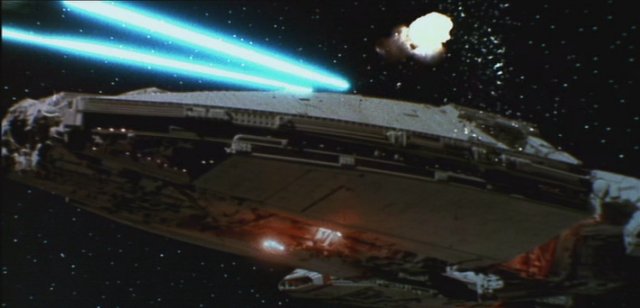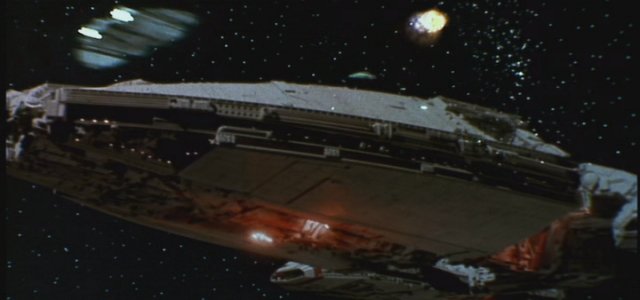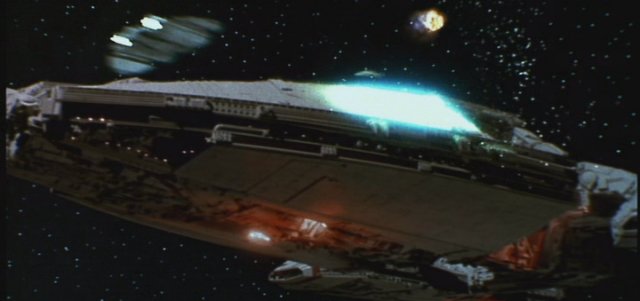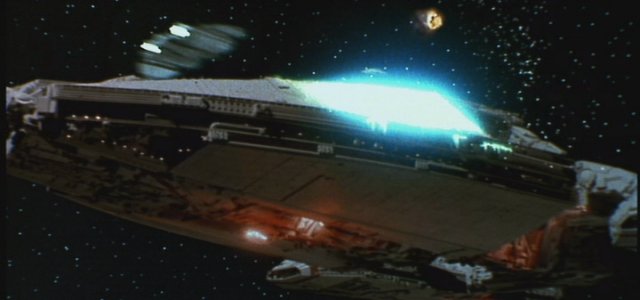Common Sci-Fi Debating Tactics and Fallacies
Written: 1999-07-27
Last revised: 2002-01-01
This is a list of common illogical debating tactics and fallacies which I have seen over and over. I suppose it should be noted that although the specific examples are set in the Star Wars vs Star Trek debate, a lot of this nonsense can be seen in other debates, such as Star Trek vs Babylon 5, and you will see people doing this on both sides.
In any case, while this page is obviously not comprehensive, it does contain examples of the most common tactics used in sci-fi debates. Some of the examples are paraphrased and some are quoted word-for-word from the original authors (all of whom shall remain nameless). See the main Myths page for some more specific sci-fi discussions.
These are "classical" debating fallacies. You can find these items in any basic logical philosophy book. I should note that this list is not complete, but it does contain some of the most popular types of logical fallacies.
Dishonest Sci-Fi Debating Tactics
These are not pure logic fallacies per se, but rather, they are bad form. In many cases, they indicate a high degree of dishonesty.
A Debating Tip
More than one Trekkie has E-mailed me to complain that I have a way of taking things from Star Trek and "twisting" them so they make Star Trek look bad. They seem to be accusing me of some sort of trick, as if I've pulled a rabbit out of a hat and it's all an illusion. However, I feel that my unconventional interpretations of ST canon events stem not from some sort of quasi-magical word wizardry, but from my refusal to interpret everything from the Trekkies' narrow perspective.
What do I mean by that, you say? Well, that's easy. Have you ever heard the parable about the six blind men inspecting an elephant? The first man touched the elephant's side, and concluded from its width and solidity that it must be a wall. The second man touched the elephant's tusk, and concluded from its sharpened tip that it must be a spear. The third man touched the elephant's trunk, and concluded from its shape and movement that it must be a snake. The fourth man touched the elephant's knee, and concluded from its thickness and shape that it must be a tree. The fifth man touched the elephant's ear, and concluded from its shape and flexibility that it must be a fan. And finally, the sixth man touched the elephant's tail, and concluded from its shape and texture that it must be a rope. They argued long and hard, not realizing that each was partly right but all were basically wrong.
So what does this have to do with Star Wars and Star Trek? That's easy; if you insist on examining things from a narrow viewpoint, you might arrive at conclusions which sound reasonable, but which are still wrong. So what is this narrow viewpoint I keep referring to? It's the assumption that you must do things the Star Trek way. I've found that people who are immersed too deeply in Trek tend to interpret everything based on whether it resembles Trek! Like the blind man inspecting an elephant's trunk, they don't realize that there are other ways of looking at it. That's the important thing to remember: to paraphrase Al Capone, the guy who's still standing is the guy who won the fight. It doesn't matter how he did it.
People like this tend to instinctively ask if a hyperdrive can duplicate the functions of a warp drive, rather than asking which one is more useful in plausible scenarios. They instinctively ask if the weaponry of the Colonial Marines in "Aliens" can duplicate the function of hand phasers, rather than asking whether they're as useful (or more useful) in plausible combat scenarios. In other words, they tend to evaluate every technology based on its ability to fit into the Trek universe. If another sci-fi series lacks a very specific capability of a particular Treknology, then it's inferior, If another sci-fi series has a specific capability not found in Trek, it's irrelevant.
So what's my suggestion for countering this mentality? Just keep an eye on them and when they start doing this, force the debate out of the "is it just like Trek" vortex and back into the "will it get the job done" arena. Evaluate everything based on absolutes, such as winning a war or defeating an enemy in combat rather than letting them ask whether it fits the Trek mould. For example, let's imagine a Babylon 5 vs Star Trek propulsion debate:
Trekkie: "Warp drive is far more flexible than event-driven B5 hyperspace jump engines. A Federation ship can engage warp drive almost instantly, maneuver while in warp, and retain full scanners, weapons, and shields the whole time. It can even warp-strafe. On the other hand, a B5 ship has to open up a gate, slowly crawl into it, and then wander around blind as a bat in a sea of orange goo, totally useless to anyone until the moment it finally drops back into realspace. When it comes to combat flexibility, warp drive has no equal in sci-fi."
B5 fan: "You're wrong about that. Federation ships have almost no maneuverability in warp. They can't warp strafe. And you're exaggerating about how slowly B5 ships move into hyperspace."
In this example, the B5 fan has made the instinctive response: answering the Trekkie's claims. But he's making the mistake of letting the Trekkie control the direction of the argument. You can already see where it's headed: the B5 fan will constantly be on the defensive, and he'll always be trying to satisfy the Trekkie's endless demands to prove that B5 hyperspace jump engines can do everything a warp drive can do. In the end, the B5 fan will lose, because B5 hyperspace jump engines can't do everything a warp drive can do. But why does that necessarily mean they're inferior? The B5 fan should swing the debate back into the realm of combat effectiveness, rather than letting the Trekkie make him answer the irrelevant question of B5's ability to mimic Trek. Here's an idea for an alternate response:
B5 fan: "Combat flexibility? What a crock. Not only are your claims mostly nonsense, but you obviously haven't considered all of the things that B5 hyperspace can do that warp drive can't. A B5 ship can hide in hyperspace as long it wants, safe from detection or attack, monitoring the Federation ship while it flies around uselessly with its silly warp drive. It can jump ahead of the Fed ship to its home base or next destination. And sooner or later, the Federation ship will give up the chase because the target is nowhere to be found. They can't stay on red alert forever, and when they stand down ... when they lower their shields and disarm their torpedoes ... when they start to relax, then BAM! A jump point forms, and the B5 ship comes screaming down on top of them with its guns blazing. Bye-bye, Federation ship. Nobody can stay on red alert forever ... <evil laugh>"
It's not a perfect rebuttal, but the point is that it's designed not to let the Trekkie fight his hypothetical war between SW and B5 on his terms. In war, the only thing that matters is defeating your enemy, and it doesn't matter how you do it. It doesn't matter whether a B5 ship (for example) can defeat a ST ship using ST tactics and ST strategies. It only matters whether a B5 ship can defeat it using its own tactics and strategies. Let the ST ship use ST tactics, but don't let the ST fan make your ship use ST tactics too.
I'm not trying to say that B5 is superior to ST in every way; I don't want to get involved in another "vs" subject. I'm just saying that Trek fans have a nasty habit of setting up Star Trek's methods as the only way to do things, so anything which deviates from this "ideal" must therefore be inferior.
Here's another example:
Trekkie: "Battlestar Galactica? Chortle ... don't make me laugh. Battlestars are so primitive that I would be very surprised if a single shuttlecraft couldn't take out an entire fleet of them. They don't have transporter technology or even shields, so they'd be utterly helpless. A Federation ship could transport its entire crew into space, or transport a bomb into its engine room, or simply fire a quantum torpedo. A single quantum torpedo would easily destroy an unshielded ship."
Galactica fan: "You can't prove that Star Trek transporters will work on a battlestar. And you're wrong about battlestars not having shield technology. They have invisible forcefields to retain the atmosphere in their landing pods even though Vipers can land, remember? And it gets better: in the "Experiment in Terra" TV episode, the Galactica stopped a surprise nuclear attack by the Eastern Alliance (a planetary superpower) by extending a forcefield over an entire hemisphere of the planet. The missiles exploded harmlessly against the forcefield, thus proving that Galactica shields can withstand the entire firepower of a nuclear first-strike from a nation with technology superior to our own."
Again, the Galactica fan instinctively tries to answer the Trekkie's accusations rather than dealing with them another way. It's actually not a bad response, but what if "Experiment in Terra" had never aired, or the Galactica fan had never seen it? Suppose the entire television series is regarded as non-canon? After all, there are no published rules on Battlestar Galactica continuity, and the television series prominently featured Baltar even though he was beheaded in the theatrical release of the original film (an alternate scene was shot for the television premiere). A rabid Trekkie might use that as an excuse to dismiss the entire television series as a bad dream (and of course, all good Galactica fans dismiss "Galactica 1980" as a horrible nightmare).
But the Trekkie's argument is based on the assumption that the bubble-style shields of Star Trek (whose appearance was actually copied from the 1953 classic "War of the Worlds") must be superior to any other defensive concept. This is an assumption for which he has no evidence. Who says that the immaterial shields used in Star Wars and Star Trek are the only way to do it? There's more than one way to skin a cat:
Galactica fan: "They mention defense shields in Galactica; who cares whether they look like TNG-style soap bubbles? Look at the accompanying screenshots:

This is the Galactica under attack. Two Cylon raider blasts are headed toward its front quarter.

This is the same scene, several frames later. The attacking raider is visible and its bolts are about to strike.

This is one frame later. The entire panel, some 5-10% of the length of the ship, glows brilliantly.

This is the next frame. The panel glows even more brightly. In the frame after this, the panel stops glowing.
You do know what this is, right? It's evidence of thermal superconductivity in the hull armour of a colonial battlestar. The bolts hit near the back of the panel (which must be a couple of hundred metres long), yet the entire panel appears to achieve roughly uniform luminosity in less than a thirtieth of a second. It's absorbing the energy of the bolt, dissipating it across the entire surface area of the panel, and then re-radiating it back into space, without suffering any visible damage. Now, it doesn't matter how they've achieved this (although it's impossible with present-day technology), but the point is that the armour is demonstrating the ability to absorb, rapidly dissipate, and then re-radiate incoming energy.
Now, let's see how how a Star Trek shield is superior. Unlike battlestar armour, it absorbs incoming energy, dissipates it over a wide area, and then ... it re-radiates it ... out into space. Hmmm ... that sounds kind of familiar, doesn't it? You seem to forget that there's more than one way to skin a cat."
Again, I'm not trying to say that Battlestar Galactica is superior to Trek in every way, or take a side in another "vs" subject. I'm only trying to point out that you can't win one of these "vs" arguments by saying, in essence, that "your sci-fi series isn't the same as my sci-fi series". In this example, the Trekkie tries to prove that Galactica is inferior because it lacks Trek-style energy shields. But the Galactica fan could just as easily argue that Trek is inferior because it lacks Galactica-style superconducting armour. It would have to come down to the same thing it always comes down to: comparing the quantity of energy that can be handled or unleashed by each of the respective ships.
To paraphrase Sun Tzu, never fight the enemy on his terms. Make him fight you on your terms.
PS. You may notice I ignored the transporter issue in the second example. That's because it doesn't have anything to do with the point I'm trying to make about narrow mindsets, and it's more of a specific "vs" issue. For what it's worth, I've noticed that Trekkies always trot out the transporter whenever comparing Trek to every other sci-fi series (almost none of which have transporters), as if its presence somehow eliminates the need for debate. According to this mentality, a little shuttlecraft's transporter makes it superior to everything from Species 8472 to the aliens who built the Dyson Sphere, the Empire from Star Wars, and Galactus from the Silver Surfer comics. It seems silly, but it's a common modus operandi among Trekkie "vs" fanatics, who are forever searching for a way to avoid dealing with direct comparisons of power. They studiously ignore all of the numerous incidents where environmental radiation, magnetic fields, extremely dense metals, or even natural minerals have stopped transporters, and insist that it's impossible to stop transporters without having transporters yourself. However, given all of the "exceptions" to their rule, it seems apparent that it's trivially easy to stop transporters once you're aware of them, and that dense armour or unusual field generators might even do it unintentionally.